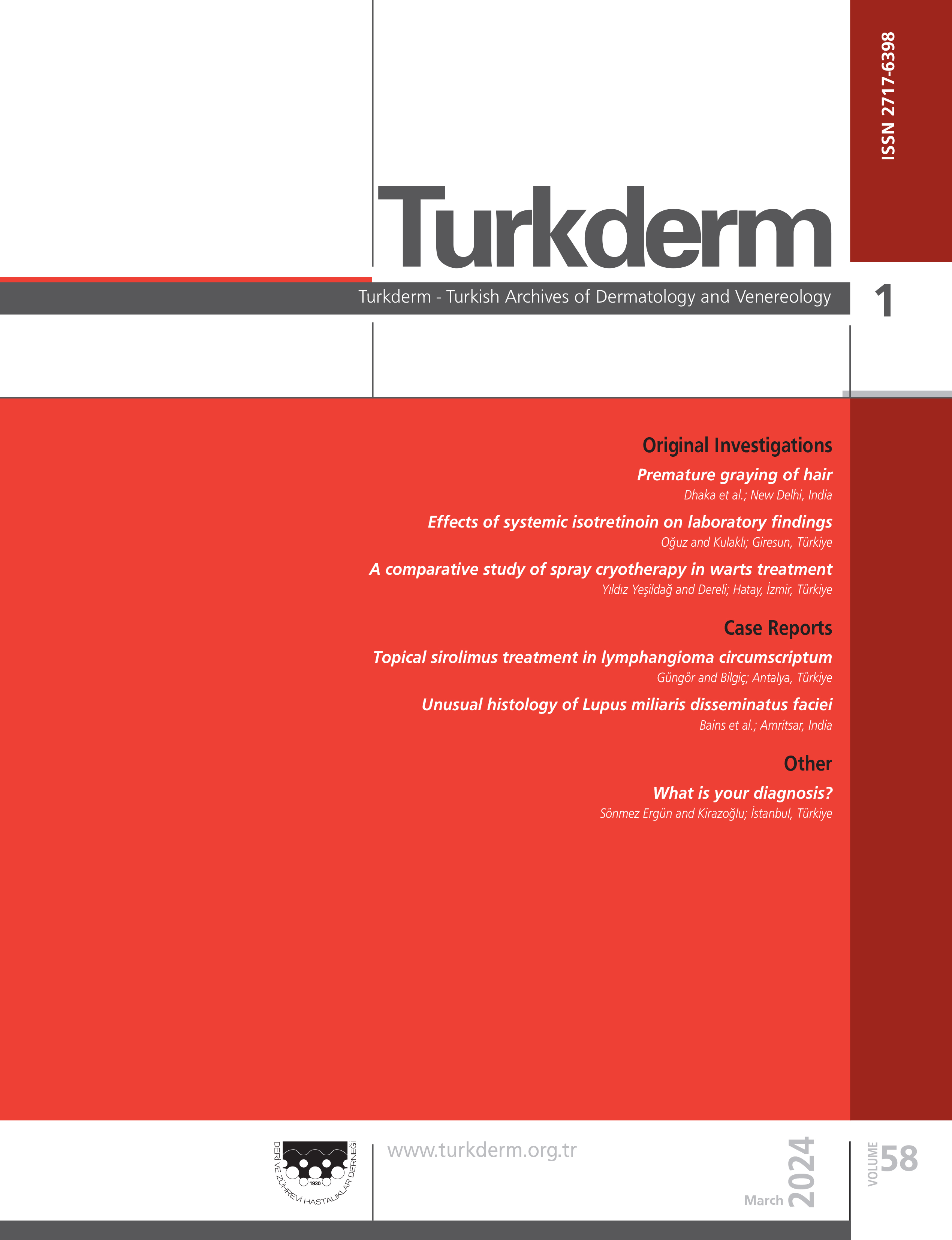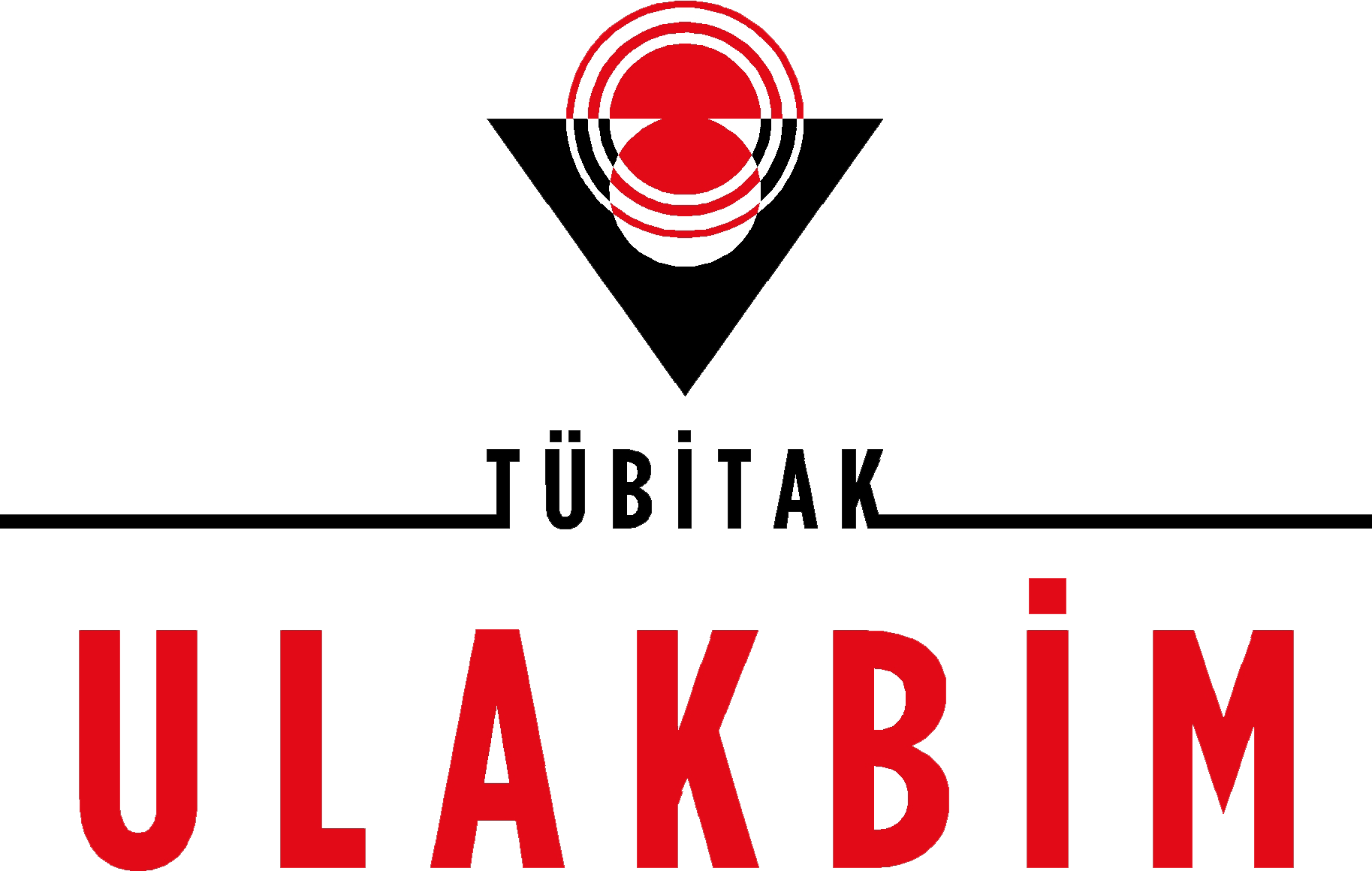Volume: 42 Issue: 3 - 2008
| EDITORIAL | |
| 1. | Dermatologic Surgery Seher Bostancı Page 76 Abstract | |
| REVIEW ARTICLE | |
| 2. | 308 nm monochromatic excimer light (MEL) in dermatology Dilek Seçkin, Tülin Ergun Pages 77 - 81 Hedefe yönelik fototerapi, yüksek doz ultraviyole (UV) radyasyonunu kısa süre içinde sadece lezyonlu deriye ulaştıran fototerapi sistemleri için yakın zamanda tanımlanmış bir kavramdır. Günümüzde, farklı emisyon spektrumuna sahip çeşitli hedefe yönelik fototerapi sistemleri bulunmaktadır. Bunlar içerisinde yer alan 308 nm monokromatik excimer ışık (MEI) sistemleri, darbant UVBden sonra, fototerapi alanındaki en önemli yeniliklerden biridir. Dalga boyu açısından darbant UVBye oldukça yakın olan bu yeni fototerapi yönteminin, başta psoriasis ve vitiligo olmak üzere çeşitli dermatolojik hastalıklarda kullanımıyla ilgili çok sayıda çalışma bulunmaktadır. 308 nm MEInın en önemli avantajları, özellikle sınırlı deri tutulumu olan hastalarda sağlam derinin gereksiz UVye maruz kalmasını önlemesi ve tedavi yanıtının, klasik fototerapi yöntemlerine göre çok daha hızlı elde edilmesidir. Bu makalede, 308 nm MEI sistemlerinin özelliklerinden ve literatürdeki bilgiler ışığında, hem günümüzdeki hem de gelecekteki potansiyel kullanım alanlarından bahsedilmektedir. Targeted phototherapy is a recently described therapeutic option in photodermatology. It is used to describe the phototherapy devices which can deliver high doses of ultraviolet (UV) radiation selectively to the involved skin. Several of these devices with different emission spectrums are currently in use. 308 nm monochromatic excimer light (MEL) is among these targeted phototherapy systems and represents one of the most important advances in phototherapy after the development of narrowband UVB. The wavelength of this new phototherapeutic option is very close to narrowband UVB. Many studies have been conducted to investigate the effectiveness of 308 nm MEL in several dermatological diseases, mainly psoriasis and vitiligo. Main advantages of MEL are protection of the healthy, uninvolved skin from excess UV radiation in patients with limited involvement and the much faster response to therapy compared with conventional phototherapies. We review in this article the properties of 308 nm MEL and discuss its current and future use in dermatology. |
| ORIGINAL INVESTIGATION | |
| 3. | Patient Profile In Dermatology Esra Adışen, Mehmet Ali Gürer, Özge Keseroğlu Pages 82 - 86 AMAÇ: Deri hastalıkları en yaygın medikal problemler arasındadır. Dermatologlar deri hastalıklarının tedavisine ek olarak kozmetik ve cerrahi işlemlerde de aktif olarak rol almaktadırlar. Bu çalışmanın amacı Ankarada özel bir dermatolog muayenehanesi ile bir Üniversite hastanesi dermatoloji polikliniğine başvuran hastaların profillerini değerlendirmektir. GEREÇ-YÖNTEM: Her iki grupta da 5952 hasta çalışma grubumuzu oluşturdu. Hastaların yaş, cinsiyet, tanıları ve başvurdukları yerler kaydedildi. BULGULAR: Özel dermatoloji muayenehanesine başvuran olguların 3778i kadın, 2174ü erkekti, yaşlarının ortalaması 37.8±15.9 yıl (6ay-81yıl), hastaneye başvuran olguların 3570i kadın, 2382si erkekti, yaşlarının ortalaması ise 37.9±18.6yıl (1-100 yıl) idi. Hastane başvurularının en önemli nedeni mantar hastalıkları, özel dermatoloji muayenesine en sık başvuru nedeni akneydi. Kadınlar, mantar hastalıkları, alopesi, tırnak bozuklukları, ürtiker, psikokutan dermatozlar ve bakteriyel enfeksiyonlar nedeniyle, erkekler ise mantar hastalıkları, akne, alopesi, ürtiker ve tırnak hastalıkları nedeniyle esas olarak hastaneyi tercih etmişlerdi. Her iki cinste de benin ve malin tümörler, nevuslar, pigmentasyon bozukluklarında özel dermatoloji muayenesinin tercih edildiği görüldü. Sifiliz, genital herpes ve anogenital verrükası bulunan erkekler esas olarak özel dermatoloji muayenehanelerini tercih ettikleri belirlendi. Özel dermatoloji muayenehanesi başvuruları içinde kozmetik uygulamalar tüm başvuruların %4nü oluşturmaktaydı. SONUÇ: Bulgularımız medikal/klinik dermatolojinin dermatoloji pratiğinin en önemli unsuru olmaya devam ettiğini göstermektedir. Kozmetik uygulamalar dışında, özel dermatoloji muayenehaneleri ile üniversite hastaneleri arasındaki en önemli fark cinsel yolla bulaşan hastalıklarda gözlenmektedir. Background and Design: Skin diseases are among the most prevalent problems in medical practice. Dermatologists have become active, not only in treatment of skin diseases, but also for the cosmetic and surgical procedures. The purpose of this study was to evaluate the profiles of patients visiting outpatient dermatology clinic of an university hospital and a private dermatologists office located in Ankara. MATERIAL-METHOD: The study comprised 5952 patients in each group. Age, gender, diagnosis, and the places they live, were all recorded. RESULTS: There were 3778 women and 2174 men with a mean age of 37.8±15.9 years (6 months-81 years) in private visit group, and 3570 women and 2382 men with a mean age of 37.9±18.6 years (1-100 years) in hospital visit group. The most common cause for visiting dermatologists office was acne. It was fungal diseases for hospital visits. Women with fungal disease, alopecia, nail disorders, urticaria, psychocutaneous dermatoses, bacterial infections, and men with fungal disease, acne, alopecia, urticaria, nail disorders, preferred hospitals over private offices. Both women and men with benign and malignant tumors, nevi, pigmentation disorders, preferred private office over hospital. Men with syphilis, genital herpes, anogenital verruca preferred mainly private offices. Visits to dermatologists office for cosmetic procedures constituted only 4% of overall visits. CONCLUSION: Our finding underscores the fact that medical or clinical dermatology continues to be the focus of most dermatology practices. Apart from cosmetic procedures, the main difference between patient profiles visiting private offices and hospitals is observed in sexually transmitted diseases. |
| 4. | The Oesophageal Involvement of Pemphigus Vulgaris Patients and Comparing with Skin Findings Sıla Şeremet, Nahide Onsun, Ahmet Danalıoğlu, Cüyan Demirkesen, M. Serkan Aygın Pages 87 - 90 AMAÇ: Pemfigus, akantoliz sonucunda intraepidermal bül oluşumuyla karakterize bir hastalık grubudur. En sık görülen formu, pemfigus vulgaris (PV) deri ve müköz membranları etkiler. Oral mukoza en sık etkilenen bölge olmakla birlikte çok katlı yassı epitel bulunan tüm vücut yüzeyleri farenks, larenks, özofagus, konjonktiva, vajinal, penil ve anal mukoza tutulabilir. Pemfigus vulgarisli hastalarda özofagus tutulumunun sıklığını saptamak ve immunhistopatolojik olarak deri bulgularıyla karşılaştırmak amacıyla çalışmamızı planladık. GEREÇ-YÖNTEM: Ocak 2004-Mart 2005 tarihleri arasında S.B. Vakıf Gureba Eğitim ve Araştırma Hastanesi Dermatoloji Kliniğine başvuran klinik, histopatolojik ve immunfloresan bulgular ile pemfigus vulgaris tanısı almış 30 hasta (23 kadın, 7 erkek) çalışmaya alındı. Direkt immun floresan inceleme için hastalardan deri biopsisi ile eşzamanlı olarak özofagoskopi yapılarak mukozal örnek alındı. Antikor düzeyleri indirekt immunfloresan (IIF) yöntemi ile tespit edildi. BULGULAR: Yirmi sekiz hastada özofagus mukozasında DİF pozitif olarak saptanırken iki hastada negatif olarak saptandı. Özofagoskopi sırasında makroskopik olarak dokuz hastada (%30) pemfigus vulgarisi destekleyen bulgu saptandı. Çalışmamızda (gastrointestinal) GIS yakınması olmamasına karşın; endoskopik bulgu saptanan dört hasta, özofagus DİF incelemesi pozitif saptanan on dokuz hasta mevcuttur. Oral mukoza lezyonu olmayan iki hastada özofagusta PV lezyonlarının saptandı. Endoskopik PV bulgusu ile yutma güçlüğü, deri tutulumu, oral mukoza tutulumu, genital mukoza tutulumu, deri DİF pozitifliği, özofagus DİF pozitifliği, İİF pozitifliği arasındaki ilişki incelendiğinde istatistiksel olarak anlamlı bir farklılık saptanmadı. Özofagus DİF pozitifliği ile deri DİF pozitifliği arasındaki ilişki incelendiğinde anlamlı derecede yüksek olarak saptandı. SONUÇ: Herhangi bir GİS semptomu olmayan hastalara, oral mukoza tutulumu olup olmadığına bakılmaksızın endoskopik özofagus incelemesinin yapılmasının yararlı ve gerekli olduğunu düşünmekteyiz. Background and Design: The pemphigus family includes a number of disease which feature intraepidermal blisters with acantholysis. Pemphigus vulgaris(PV) is the most common form of pemphigus, affects the skin and mucous membranes. Although oral mucosa is the most commonly affected site, all stratified squamous epithelium can be involved like pharynx, larynx, oesophagus, conjunctiva, vaginal, penile, and anal mucosa. We planned our study aiming to find frequency of oesophagus involvement in PV patients and to compare them immunohistopathologically with skin findings. MATERIAL-METHOD: Twenty three female and seven male patients, who were admitted to The Health Ministry Vakıf Gureba Education and Research Hospital, Dermatology Clinic, in between January 2004 and March 2005, and were accepted as PV according to clinical and immunohistopathological findings. Mucosal biopsies were taken by oesophagoscopy from patients in the same time with skin biopsies for DIF examination. Antibody titers in serum was detected by indirect immunofluorescein method. RESULTS: DIF was positive in twenty eight patients while two patients had negative results. During oesophagoscopy, macroscopically nine patients (%30) had esophageal lesions supporting pemphigus vulgaris.When a relationship were examined between dysphagia with endoscopic pemphigus vulgaris findings, skin involvement, oral mucosal involvement, genital mucosal involvement, skin DIF positivity, oesophagus DIF positivity, IIF positivity, no meaningful difference was found istatistically. In our study, four patients had endoscopic findings and nineteen patients had positive DIF results although they did not have gastrointestinal symptoms. When relationship between oesophageal DIF positivity and skin DIF positivity was examined, there was a positive correlation meaningfully. CONCLUSION: According to our article we believe that upper GI endoscopy is a useful and neccessary diagnostic method in pemphigus vulgaris patients who have gastrointestinal symptoms without looking for oral mucosa involvement and it should be a standard diagnostic procedure in these patients. |
| 5. | Comparison of the methods for the diagnosis of onychomycosis Eylem Ceren, Tuğba Rezan Ekmekci, Damlanur Sakız, Adem Köşlü, Banu Bayraktar Pages 91 - 93 AMAÇ: Onikomikoz tanısında sıklıkla kullanılan yöntemler; potasyum hidroksit (KOH) ile direk mikroskobik inceleme, PAS boyası ile histopatolojik değerlendirme ve fungal kültürdür. Amacımız onikomikoz tanısında kullanılan bu üç yöntemi karşılaştırmaktı. GEREÇ-YÖNTEM: Ayak tırnaklarında klinik olarak onikomikoz düşünülen 100 olgu çalışmaya alındı. Üç tanı testi her olguya yapıldı. Klinik şüphe ve en az bir testin pozitif olması halinde onikomikoz tanısı kondu. Buna göre; tanı testlerinin herbiri için; duyarlılık ve negatif prediktif değer hesaplandı. BULGULAR: Olguların 92 sinde (%92) en az bir test pozitifti. Metodların duyarlılığı sırasıyla, KOH ile direk mikroskobik incelemede %92, PAS boyası ile histopatolojik değerlendirmede %80 ve kültürde %20 idi. Negatif prediktif değerler ise sırasıyla %53, %42 ve %10 idi. SONUÇ: KOH ile direk mikroskobik inceleme onikomikoz tanısında en duyarlı testtir. Yüksek negatif prediktif değeri ile de bunu destekler. Background and Design: A potassium hydroxide (KOH) direct microscopic examination, histopathological investigation with periodic acid-Schiff (PAS) stain and fungal culture are common diagnostic methods in the diagnosis of onychomycosis. The purpose of this study was to compare these three methods for the diagnosis of onychomycosis. MATERIAL-METHOD: A total of 100 patients who were suspected clinically of having onychomycosis on their toenails were included in this study. Three diagnostic tests were performed for each patients. In addition to clinical suspicion when one of the diagnostic tests was positive the diagnosis of onychomycosis was made. Accordingly, the sensitivity and the negative predictive value were calculated for each diagnostic test. RESULTS: In 92 (92%) of the patients, at least one of the three diagnostic methods was positive. The sensitivites of these methods were as follows: KOH direct microscopic examination, 92%; histopathological investigation with PAS stain, 80%; and culture, 20%. Their negative predictive values were also 53%, 42%, and 10% respectively. CONCLUSION: KOH direct microscopic examination is the most sensitive method for the diagnosis of onychomycosis. Its high negative predictive value supports this finding. |
| CASE REPORT | |
| 6. | A case with Bloom Syndrome Nida Kaçar, Murat Kadri Erdoğan, Berna Şanlı Erdoğan, Münevver Atmaca, Füsun Düzcan Pages 94 - 96 Bloom sendromu (BS) telenjiyektaziler, fotosensitivite, büyüme geriliği, immünyetmezlik, maliniteler ve diabete yatkınlıkla karakterize otozomal resesif geçişli nadir görülen bir sendromdur. Genç yaşlarda neoplazi gelişimi açısından yüksek risk bulunmaktadır. Belirgin genetik kararsızlık gösteren BSda mitotik hücrelerde kromozom kırıkları ve kardeş kromatid değişiminde artma gözlenir. On altı yaşında erkek hasta yüzünde bebeklik döneminden beri mevcut olan kızarıklık yakınması ile başvurdu. Gelişme geriliği saptanan hastanın fizik muayenesinde ince uzun yüz, prognatizm, yüzde her iki malar bölge, burun dorsali, alın ve şakakları kaplayan retiküler tarzda, basmakla yer yer solan ve telenjiyektaziler içeren eritemli yama mevcuttu. Sitogenetik analizde kardeş kromatid kırığı sayısı ortalama 107/hücre olarak saptanan hastaya fenotipik bulgularıyla birlikte BS tanısı konuldu. Aileye genetik danışma verilerek olgu kanser gelişme riski açısından takibe alındı. BS is a rare, autosomal recessive disorder characterized by telangiectasias, photosensitivity, growth deficiency of prenatal onset, immunodeficiency, increased susceptibility to malignancies and diabetes mellitus. There is an increased risk of developing neoplasia at early ages. Chromosomal fractures and an increase in sister chromatid exchanges are observed in BS that presents prominent genetic instability. A sixteen year old boy applied to our clinic with complaint of erythema on his face having existed since infancy. In physical examination of the patient in whom growth retardancy has been determined, a narrow, long face, prognatism, an erythematous telangiectatic blanchable patch involving malar areas, nose, forehead, and temples have been established. The patient whose sister chromatid exchange number was determined as 107/cell in cytogenetic analyse, was cited as BS together with his phenotypic findings. The patient has been taken into follow-up in terms of cancer risk and the family was genetically informed. |
| 7. | A case of porokeratosis showing different clinical patterns of the disease with anogenital involvement Özlem Karabudak, Bilal Doğan, Aptullah Haholu, Yavuz Harmanyeri Pages 97 - 99 Porokeratozis (PK), sınırında skuamın olduğu, histopatolojik olarak kornoid lameldenilen parakeratotik keratinositlerin oluşturduğu sütunla karakterize bir grup keratinizasyon bozukluğudur (1). Klinik olarak porokeratozis Mibelli (PM), linear porokeratozis (LP), dissemine superfisial aktinik porokeratozis(DSAP), punktat porokeratozis (PP), palmoplantar porokeratozis(PPP) ve dev porokeratozis (DP) gibi formları bildirilmiştir. Malign epitelial tümör gelişme riski nedeniyle tedavi edilmesi gerekir. 21 yaşında bir erkek hastayı el, ayak, skrotum, oral ve anal mukozadaki lezyonları nedeniyle sunmaktayız. Biyopsilerin histopatolojik incelemesi, tipik porokeratozis özellikleri göstermekteydi. Lezyonlara kriyoterapi uygulandı. Burada PM olgusunu çok sayıda lezyonun oral, anal, skrotal tutulumla birarada ender olarak görülmesi nedeniyle sunmaktayız. Porokeratosis (PK) is a group of cutaneous entities characterized by marginate scaling lesions, histologically showing a column of parakeratotic keratinocytes (cornoid lamella). Various forms are recognized such as porokeratosis of Mibelli (PM), linear porokeratosis, disseminated superficial actinic porokeratosis, punctate parakeratosis. PM should be treated because of the possibility of developing malignant epithelial tumors. We are presenting a 21 year old male patient suffering from PM on the back of the hands, foot, scrotum, oral mucosa and anal region. The histological biopsy specimens showed the characteristic features of porokeratosis. We destroyed the lesions by cryotherapy sessions. Here, we present a case of PM since it is rarely seen as multiple lesions with oral, anal and scrotal involvements altogether. |
| WHAT IS YOUR DIAGNOSIS? | |
| 8. | Itchy Papules Yeliz Erdemoğlu Page 100 Abstract | |
| NEWS | |
| 9. | Hem Haber ve Hem de Son Yazı ! Ertuğrul H. AydemirPage 101 Abstract | |
| NEW PUBLICATIONS | |
| 10. | Yeni Yayınlar Page 102 Abstract | |
| TURKDERM-6637 | |
| 11. | Kongre Takvimi Page 103 Abstract | |






















